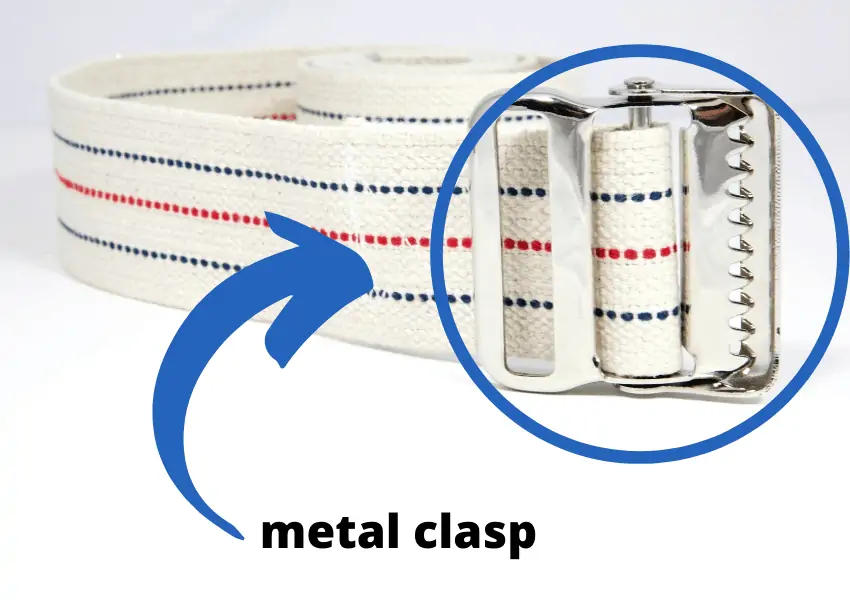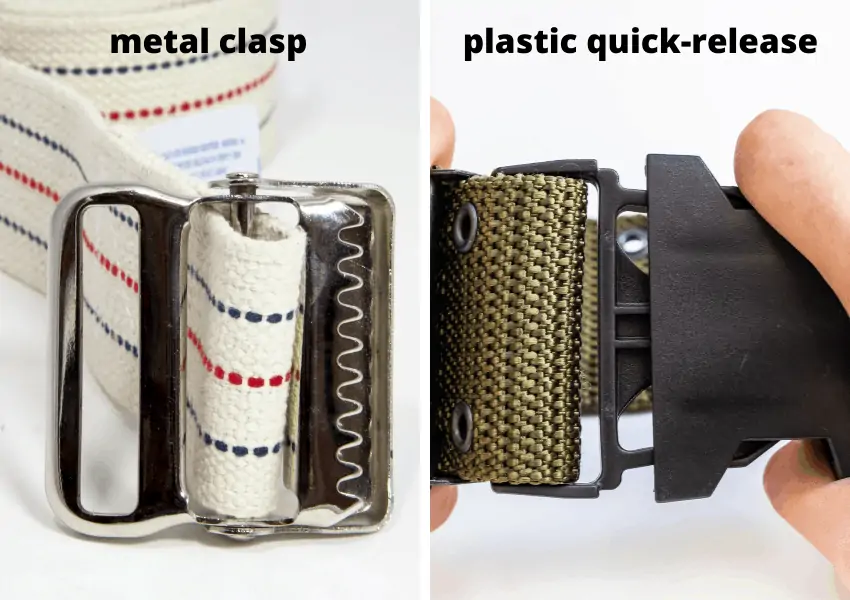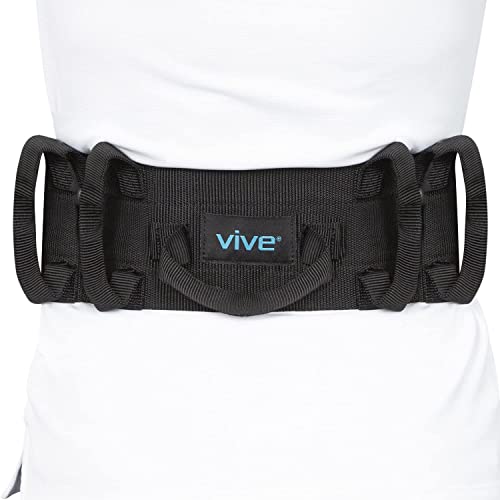Have you ever been helping your senior loved one walk, or stand up from a chair, and had to grab them by their arm or the seat of their pants? Worse than undignified – this can be dangerous for both of you!
This scenario can be avoided by using a simple, inexpensive transfer belt. Many seniors who need assistance transferring – moving from one bed or seat to another – can benefit a lot from the use of a transfer belt!
Transfer and gait belts make moving an elderly senior around easier and safer, as it protects both the senior and the caregiver from serious injuries.
In this guide, we’ll dive into everything you need to know about transfer belts and gait belts, as well as review some of our top picks for the best gait belts!
Quick Note: Gait vs Transfer Belts – What’s the Difference?
Gait belts are very similar to transfer belts – in fact, the two are often used interchangeably! Gait belts are designed specifically to assist unsteady seniors to walk safely, while transfer belts are for moving an individual from one location to another (for example, from a wheelchair to a bed). The name difference comes from how the belt is used, but often the same belt product can be used for transfer and gait assistance!
Confused? No worries! We’re here to help you figure out which gait or transfer belt will meet your needs, and point you in the direction of some top choices.
Best Gait Belts and Transfer Belts for the Elderly
Let’s take a look at the top gait transfer belts for elderly seniors!
1. Secure Gait Belt
About: The Secure Gait Belt is small, strong, simple, and subtle. Its two-inch width and cotton webbing construction is comfortable enough to wear even for extended periods.
Features:
- 100% woven cotton webbing
- Machine washable
- Metal buckle with teeth
What it lacks in bells and whistles, the Secure Gait Belt makes up for in durability. It can stand up to repeated machine washing and drying, even at the high temperatures needed for optimal sanitation.
In fact, the Secure Gait Belt is so dependable and durable, many professional caregivers and therapists choose to use it in their practice!
This Secure Gait Belt is small and inexpensive, which makes it easy to tuck away in a wheelchair pouch or handbag. Many seniors like to keep an extra one in the car, or keep a couple on hand around the house.
The teeth of its metal buckle lock into place anywhere along the belt for a perfect fit for most seniors. The basic model is 60 inches long, but there is also a 72 inch model available for seniors with a larger waist. The built-in belt loop holder neatly tucks away any excess length.
Technical Specifications
- Weight Capacity: 350 pounds
- Length: 60 inches
- Width: 2 inches
- Number of Handles: none
- Material: Cotton webbing
- Closure: Metal buckle
Pros
- Inexpensive
- Belt loop holder
- Machine washable
Cons
- No handles
- Two inch width may not be as comfortable for transfers as a four inch belt
2. LiftAid Gait Belt
About: Who says gait belts have to look like medical devices? This LiftAid Gait Belt is available in a selection of several stylish colors for fashion-conscious seniors!
Features:
- Fun color options
- Machine washable
- Compact size for easy storage and transportation
- Metal buckle with locking teeth
The LiftAid is a high-quality, basic gait belt with a strong metal buckle. It accommodates individuals weighing as much as 300 pounds.
There are no handles, so the LiftAid Gait Belt is best used as a walking belt for unsteady seniors.
Its small size makes it easy to keep in a handbag, wheelchair pocket, or glove compartment for quick and easy access when needed.
The LiftAid belt is machine washable, even at high temperatures for thorough sanitation.
Technical Specifications
- Weight Capacity: 300 pounds
- Length: 60 inches
- Width: 2 inches
- Number of Handles: none
- Material: Cotton webbing
- Closure: Metal buckle with locking teeth
Pros
- Several fun, colorful options
- Compact size is easy to transport or store
- Inexpensive
Cons
- No handles
- Two inch width may not be as comfortable for transfers as a four inch belt
3. Secure Transfer Belt
About: The Secure Transfer Belt fits a wide range of waist sizes – between 28 and 51 inches – so it can comfortably accommodate seniors of most sizes. Once set to the senior’s size, its quick-release buckle makes applying and removing this belt almost effortless.
Features:
- Four inch width provides extra support and comfort
- Six handles for leverage and grip from various angles
- Machine washable
The Secure Transfer Belt’s ample four-inch width provides extra contact area, which disperses pressure better than narrower belts.
This Secure belt features six handles that can help optimize leverage and grip from a number of different angles. The handles may not be as comfortable to grip as those with padding, but they do take up less room, so they can easily fold up to slip into a recliner pocket, wheelchair backpack, or day bag.
This transfer belt is machine washable and dryable on a lower heat setting for easy and convenient cleaning. However, this Secure belt can’t stand up to the hotter temperatures needed for ideal sanitation for those with serious infection control concerns.
Technical Specifications
- Weight Capacity: none specified
- Length: 52 inches
- Width: 4 inch
- Number of Handles: 6
- Material: Nylon webbing
- Closure: Plastic Quick Release Buckle
Pros
- Comfortable four inch width
- Six handles for easy gripping
- Machine washable
Cons
- Quick release buckles can sometimes be harder to use for caregivers with weak or painful hands
4. Vive Transfer Belt with Handles
About: The Vive Transfer Belt with Handles has everything that most seniors need in a basic transfer belt. It features padded handles, is machine washable and it fits most waist sizes. It’s a straightforward, solid, quality belt at a reasonably low price point.
Features:
- Six padded handles
- Machine washable
- Suitable for bariatric use
The Vive features a durable metal buckle suitable for bariatric use, and accommodates seniors with waist size of up to 51 inches.
The Vive’s four-inch width provides a nice, wide area of contact with the senior, which disperses pressure to keep the belt in place comfortably without sliding up.
This Vive transfer belt features six padded handles – both vertical and horizontal – to enable the caregiver to find angles with the best leverage and comfort from any position.
Machine wash and tumble dry for convenient sanitation.
Technical Specifications
- Weight Capacity: unspecified
- Length: 55 inches
- Width: 4 inches
- Number of Handles: 6
- Material: Nylon webbing
- Closure: Metal with locking teeth
Pros
- Six padded handles
- Machine washable
- Four-inch width for a comfortable fit
- Suitable for waist circumference of up to 51 inches
Cons
- Metal buckles can slip or loosen if not threaded correctly
5. Patient Aid Extra Long Gait Belt
About: The Patient Aid Extra Long Gait Belt is one of the longest transfer gait belts with handles available. It’s a welcome find for larger seniors seeking a comfortable four-inch width. Multiple well-padded handles mean caregivers can enjoy a secure grip and optimal leverage from any angle – without the discomfort that can accompany non-padded handles!
Features:
- Horizontal and vertical padded handles
- Quick release buckle latch
- Bariatric strength
The Patient Aid Extra Long Gait Belt is made from durable nylon webbing, and is reinforced with double stitching for dependable performance. It’s strong enough for bariatric use, and can adjust for waist sizes from 25.5 to 52 inches.
The quick release buckle makes it easy to put on and release, although it might be a little challenging to release for an individual with weak or arthritic hands.
Technical Specifications
- Weight Capacity: not specified
- Length: Adjustable from 25.5 to 52 inches
- Width: 4 inches
- Number of Handles: 6
- Material: Nylon
- Closure: Quick release plastic buckle
Pros
- Extra-long length accommodates larger waists
- Four-inch width for comfort
- Cushioned handles
Cons
- Quick-release buckles are sometimes hard to manage for individuals with poor hand strength
6. Dr. Moe’s Solutions Gait Belt
About: The big rubber handles on Dr. Moe’s Solutions Gait Belt were strategically designed by an experienced physical therapist to maximize caregiver leverage, reduce strain on the caregiver’s wrists, and make transfers as easy and safe as possible. Plus, you get a second belt for the caregiver to use for free!
Features:
- Strategically placed handles maximize leverage
- Strong enough for bariatric use – up to a 51 inch waist circumference
- Get a second caregiver belt free
Dr. Moe’s big handles are rubberized for great grip, and are easy to wipe down and sanitize. However, they lack padding, so they may not be as comfortable to hold as some of the cushier handholds on other models.
Dr. Moe’s belt is designed for use by seniors with waist sizes ranging from 29.5 to 51 inches. It is strong and durable for use as a bariatric gait belt.
A second belt is included for the caregiver to wear. Not only does this promote good body posture for safety, it also provides the perfect place for the senior to hold during the transfer. Placing their hands on the caregiver’s belt optimizes leverage and keeps their arms off of the caregiver’s neck.
When hands are around a caregiver’s neck, there’s a much higher risk of serious spinal injury, so it’s important to keep hands safely away from that area during transfers! Having the senior hold onto the belt is a perfect solution!
Technical Specifications
- Weight Capacity: unspecified (approved for bariatric use)
- Length: Fits waists from 29.5 to 51 inches
- Width: 4 inches
- Number of Handles: 5
- Material: Nylon
- Closure: Quick release plastic buckle
Pros
- Handles are placed for optimum leverage and to reduce caregiver strain
- Second caregiver belt included
- Bariatric use approved
Cons
- Quick release buckle may be slightly difficult for individuals with poor hand strength to use
- Handles are not padded
The Best Transfer Belt Alternative: The Transfer Sling
Gait belts and transfer belts aren’t appropriate in every situation. Seniors with sensitive abdomens, and those certain medical devices around the middle, shouldn’t use them. Luckily, there are other products designed with these needs in mind, such as the Vive Transfer Sling.
1. Vive Transfer Sling
About: The Vive Transfer Sling’s extra-wide design provides secure and comfortable support during transfers. The sling wraps around the low back, and features an open front for seniors who may have abdominal sensitivity.
Features:
- Extra-wide for extra comfort
- High-friction lining prevents slipping
- Optional waist belt for enhanced security
- 10 padded handles
The Vive Transfer Sling includes ten lightly textured, padded handles for a comfortable and secure grip, providing excellent leverage from many angles. It can be used for transfers to and from the bed, wheelchair, commode, or car!
The high-friction lining keeps the Vive sling in place, preventing slipping, bunching or riding up during use. An optional waist belt with quick-release buckle is included, which can be used for added security if desired.
Technical Specifications:
- Weight Capacity: 330 pounds
- Length: 36 inches
- Width: 9.65 inches
- Number of Handles: 10
- Material: Polyester
- Closure: Quick release buckle (use of waist strap is optional)
Pros
- Open-front design is compatible with abdominal sensitivity or medical devices, such as catheters, colostomy bags or feeding tubes.
- Optional waist strap
- Ten textured padded handles
Cons
- Spot clean only
Essential Need-to-Know Info About Gait Belts
When are gait belts helpful? When are they not a good choice? How do you use one? Which features should you consider when looking for the best gait belts for seniors? In this section, we’ll cover all these questions and more!
What are Gait Belts Used For?
A gait belt is a long, strong belt that can be placed over the clothing of a person who needs some assistance to walk or transfer safely. It provides a sturdy handhold that allows the caregiver to easily right a wobble, guide movement, or lend a little strength to a senior who needs it.

Gait Belts Help Prevent Falls
Gait and transfer belts are intended for seniors or people with disabilities who may be at risk for falling when walking or transferring due to conditions such as:
- Dizziness
- Weakness
- One-sided paralysis
- Hip, foot or leg pain
- A trick knee or ankle that sometimes give out
- Unsteady when walking
- Poor balance
Gait and transfer belts should be used when a professional or family caregiver assists a senior with walking, getting out of bed, or other transfers.
However, they should not be used with seniors who are uncooperative, unable to stand on their own at all, or who have certain medical conditions or devices in their abdomens. (Read more on that below.)
Even though they are occasionally called “lifting belts”, gait belts are not intended for lifting people! If a senior cannot stand on their own (at least for a few moments, to move from one seat to another with assistance), gait belts are not appropriate – a mechanical lift would be needed instead.
When used properly, gait belts help keep the senior safe and steady, and prevent injuries to the caregiver.
Gait Belts Help Keep Professional and Family Caregivers Safe
The risk of injury is high when lifting and moving people! The CDC notes that healthcare workers who do so experience 3-5 times the rate of muscle and skeletal injuries over the rest of the population!
According to the U.S. Occupational Safety & Health Administration, lifting, transferring, and repositioning others is a major source of injuries every year, even to professionally trained caregivers!
Sprains and strains are among the most common injuries reported, and they most often occur in caregivers’ shoulders and lower backs. Unfortunately, all too often these sprains, strains, and other injuries translate to long-term chronic pain and permanent injuries.
The danger is due in large part to the awkward positions people end up in when assisting those in need, such as twisting or bending while lifting. Especially high-risk activities include;
- Transferring between chair and toilet
- Transferring between bathtub and chair
- Transferring from chair to bed
A gait or transfer belt helps eliminate the risk of falling, which can injure the senior, as well as the caregiver! Transfer belts also help reduce the awkward positioning caregivers must employ by providing a sturdy handhold that can be used to position the senior easily and offering additional leverage to reduce the effort and exertion it takes to help someone up.
What Movements Do Gait Belts Help With?
While gait belts should never be used for lifting, they can be used in a lot of other situations!
1. Walking
Gait belts can help a caregiver safely steady a senior as they walk. The gait belt wraps around the senior’s waist and provides a sturdy handhold for the caregiver. If the senior starts to lose their balance, the caregiver can right them with the belt.

Without a gait belt, the caregiver may resort to grabbing the senior’s arm, which may result in serious injuries.
Gait belts can be used along with canes, walkers, or other assistive devices to make walking safe and successful.
2. Transferring
The term “transferring” refers to moving from one position to another. Whether it’s getting out of bed, moving from a wheelchair to a commode, or into a car, transferring can be risky and difficult.

Many older adults require a little assistance with different types of transfers, such as:
- Getting out of bed
- Getting in and out of a car
- Getting in or out of a wheelchair
- Standing up from a sofa or lift chair recliner
- Standing up from a chair
- Getting up from the floor after a fall
Without a transfer belt, some caregivers may pull on the pant waist to give a senior a boost up from a chair. This can be undignified as well as uncomfortable – and unsafe! A transfer or gait belt is a much better option. It provides a handhold to assist the senior up much more safely and comfortably.
3. Assisting Someone Down to the Floor
If you’re walking with an elderly family member and they start to fall, gait belts can help you steady them and gently help them down to the floor, often preventing them from falling.
4. Assisting Someone Up from the Floor
When a fall – or a gentle lowering to the floor – has occurred, getting up afterward can be tough! If you’re certain the senior isn’t injured, a gait belt can help them stand back up safely.

Note: Gait Belts are NOT for Lifting
Remember, gait belts and transfer belts aren’t intended to lift someone. There are other transfer garments out there – like certain transfer vests – that are safe for lifting, if you need it. There are also various mechanical hoists or inflatable lifts that can help.
What is the Difference Between a Transfer Belt and a Gait Belt?
A transfer belt is basically a gait belt with handles. The handles add leverage and enhance comfort.
Gait belts are mainly intended to provide a steady hand to someone who is walking. In fact, the word “gait” means walk!
Transfer belts were specifically designed for individuals who need assistance standing up and transferring to another chair.
However, many people use the terms interchangeably, and to a large extent, either type of belt can be used for either walking or transferring. Based on each senior’s specific needs, one type of belt or another may offer better support or a more comfortable experience.
How to Put On and Fit a Gait Belt
Most gait and transfer belts are designed to be placed very snugly around the waist of the senior. It should be below the ribcage and above the pelvis. If the breasts reach down into this area, be sure the belt is placed underneath them.
You should just be able to barely slip two fingers between the belt and the senior’s torso. This can seem too tight at first, and many people make the mistake of leaving it too loose. However, if it’s too loose, the belt can slip during the transfer, which could lead to a fall or injury!
Once the senior stands up, their abdominal shape changes, and the belt may need to be retightened.
Once the belt is tightened there is often extra length left over. Some belts feature a special loop to hold the extra length. If not, just tuck it into the belt in the back so it stays out of the way and doesn’t get tangled up in anyone’s legs!
Some bariatric gait belts are designed to be used higher, up around the chest of the senior. Check the instructions for your model, or check with a physical therapist, to ensure that this is a safe placement for your senior.
Most gait and transfer belts have either a metal buckle or a quick-release clasp, which should usually be placed in front – although you can slide a quick-release buckle around to the back to reduce the chance that a senior may accidentally open it.
Metal buckles have teeth that “bite” into the fabric of the belt to hold it securely in place. The belts must be woven through the buckle in the right order. If not, the teeth can’t grab hold and it can easily slip out of place.
Using a Metal Buckle

Metal buckles are easy to use for most, although sometimes people have a little trouble figuring out or remembering the order to weave the belt through the buckle. The main thing is to be sure that the tooth side of the buckle is facing outward!
- The tooth side should be facing outward
- Slide the end of the belt through the tooth end of the buckle and pull until snug
- Double check to be sure the teeth are pressing into the fabric (they will be if they were facing outward to begin with!)
- Slide the end of the belt through the open part of the buckle
- Secure any extra length of belt in a loop or tuck it into the belt to keep it out of the way
Some people find it helpful to remember that it’s just like eating: first you “Chew” the end of the belt with your teeth, and then “Swallow” it through the opening!
Using a Plastic Quick Release Buckle
Quick-release clasps are pretty easy to use for most individuals. They clasp together easily, as the male end of the buckle snaps right into the female end. The buckle is released by pressing in on two tabs, which could be a bit of a challenge for some individuals with weak or arthritic hands.
You’ll need to adjust the belt to the senior’s waist size initially. It will stay where it’s set, so you shouldn’t have to do this often – but check each time you put it on to ensure it still fits properly and go ahead and adjust if needed.
How to Use a Gait Belt
Once the gait belt is properly placed and fitted, it’s time to stand up!
- Remind the senior to lean forward with their “nose over toes” to help them stand up most easily.
- Their feet should be flat on the floor.
- Encourage them to push up on the armrests, or pull up on a transfer pole or bed rail, if possible.
- Count to three so you’re both coordinated and working together.
Stand behind them and slightly off to their weaker side.
If you’re using a standard gait belt with no handles, hold the belt from behind with an underhanded grip. Your fingertips should be under the belt and pointed up towards their head. This provides the strongest grip and reduces the risk of injuring yourself as the caregiver.
If your transfer belt has handles, hold the one that gives you the most comfort and best leverage.
If the senior is fairly steady, you may need to just barely touch the belt so you’ll be in position to steady them if needed.
For individuals with poor strength or balance, you’ll need to keep your hand firmly on the belt. You may need to hold on to both the back and front of the belt, or have a second person to help if they are very weak or unsteady.
If two people are helping, each should stand on opposite sides, with hands on both the front and back of the belt for maximum support.
The video below offers a great demo on how to use a transfer gait belt:
How to Use a Gait Belt to Prevent a Fall
You should always be standing behind and slightly to the side of a person when you’re assisting them with a gait belt.
If the senior starts to lose their balance, you may be able to steady them simply by holding the belt firmly. If not, try to steady them by stepping right behind them, and pulling them gently toward your body.
If pulling them toward your body isn’t enough to prevent the fall, use the gait belt to gently guide them to rest against the large strong muscle of your thigh. From this position, you can slide them safely and slowly down to the floor, which can keep them from getting hurt.
How to Use a Gait Belt to Help a Senior Up from the Floor
When a senior has fallen or has been gently lowered to the floor to prevent a fall, a transfer belt can sometimes help get them up. First, be sure they are not injured.
With One Helper
- The senior will need to do most of the work of standing up on their own. (If they can’t, and you don’t have lifting equipment available to help them up, call for assistance.)
- Help them roll to their side.
- Place a sturdy dining chair in front of them, and ask them to get on their hands and knees.
- Put the gait or transfer belt around their waist.
- Ask them to place their hands on the seat of the chair for support as they bring one knee forward. They should have one foot flat on the floor, as in a lunge position.
- Place a second dining chair behind them. Ask them to push up with their hands and legs to a standing position. You can use the gait belt to guide them onto the seat behind them. Don’t lift them.
With Two Helpers
If you have two people available to help up a senior who is not injured, a transfer belt can be especially useful. Narrow gait belts put a lot of pressure on the abdomen, so they may not be as comfortable as four-inch transfer belts. The handles help a lot, too, because they’re easier and more comfortable to grab.
- Have the senior sit up on the floor.
- Place the transfer belt around their waist.
- Place a chair behind them.
- Ensure the senior is wearing sturdy non-slip shoes and their feet are flat on the floor.
- The two helpers should squat on each side of the senior, without bending down, which would endanger their backs. Each should hold a handle of the belt and one of the senior’s hands.
- When they are ready, count to three so everyone is coordinated.
- The senior should stand up with the helpers’ assistance.
- The helpers can guide the senior into the chair and help them get comfortable.
Always notify the senior’s doctor of every fall, even if there was no injury.
Features to Consider When Selecting a Gait Transfer Belt
Features to consider when selecting a transfer belt or gait belt include its width, handles, type of closure, and material.
Width
Standard, basic gait belts are about two inches wide. This narrow width makes these belts easy to store, toss in the glove compartment of a car, or tuck away in a handbag.
The wider transfer belts tend to be around four inches wide. The extra width is more comfortable for many seniors, as the larger area helps disperses the pressure.
Handles
Most transfer belts come with handles, which can be more comfortable for both the senior and caregiver.
When a caregiver grasps a gait belt directly, the senior may find it uncomfortable to have a hand pressing into their back, and the caregiver may find the angle to be awkward for their wrist. Handles can help in both situations!
Good handle placement can reduce the amount of strain in the caregiver’s wrists or arms, and can optimize leverage to make the transfer as easy as possible.
Different belts feature various combinations of horizontal, vertical, and sometimes even diagonal handles.
Having a variety of handle directions and positions gives the caregiver lots of angles to work with. Since what is ideal will vary with body sizes, shapes, and locations of transfers, it’s nice to have options!
Padded handles tend to be easier and more comfortable to hold onto than non-padded ones, but they are generally more expensive. They’re also a bit bulkier, so they’re not quite as convenient to tuck away for travel or storage.
Type of Closure
The two main types of closures on gait or transfer belts are metal clasps and plastic quick-release buckles. Both are strong and dependable options.

Most metal clasps feature teeth that bite into the fabric of the belt to keep it securely in place. It is important that the belt be woven correctly through the teeth to ensure its safety.
It tends to be a bit quicker to adjust the fit from person to person with these metal clasps, so they are often favored by professionals who use the same belt for different patients.
On the other hand, plastic buckles can be a little quicker to place or release when no size adjustments are needed. If you’re using it for only one person, you can set its size once, and it remains there as you snap the buckle open or closed.
Neither type of closure is really that much quicker to use than the other.
The main difference between the two is that the quick-release mechanism may be a bit challenging for individuals with poor hand strength to squeeze to release. The metal buckles with teeth that “bite” or lock into the fabric belts are easier in that regard.
However, on the flip side, if you don’t thread the metal buckles correctly they won’t hold well. This can be dangerous in some situations, because if the belt doesn’t hold tight, it can slip out of place, leading to potential injuries. Threading the buckle is easy enough to do, especially once you have gotten used to it, but some people find it just a bit tricky to figure out or to remember how to do it.
Really, in most cases, the differences are minor enough that it just boils down to personal preference.
Material
Most gait belts are made from nylon canvas, woven cotton, or cotton blends. All are designed for strength and durability. Check the weight limit – if one is specified – to ensure it’s rated high enough for your needs.

Gait belts should never be used against bare skin, so don’t worry too much about the softness of the material itself – although it’s true that flexible, breathable material like cotton can feel better even over the top of clothing than something stiffer, like nylon.
Certain materials are machine washable, while others are limited to hand-washing. Some are made to be wiped down easily with spray cleaner. Those that can be wiped down can be better for infection control if the belt is being shared between two or more people. If you’re looking for something for one person’s use, wiping down isn’t usually necessary,
Consider your hygiene and infection control needs and check the washing instructions prior to making your selection.
When are Gait Belts a Bad Choice?
When used properly, gait belts can be an excellent way to enhance safety for both the senior and the caregiver. However, there are times they just aren’t a good choice.
When the Senior Can’t Stand Up
Transfer and gait belts are intended to assist a person to their feet, or steady them as they walk when their balance is impaired.
Gait belts are not intended for use with individuals who cannot stand on their own, at least for a few moments. Using a belt to transfer a person who cannot stand or do some of the work of the transfer can lead to serious injuries.
If a person can’t stand up or bear their own weight, a mechanical lift is more appropriate for their needs.
When the Senior has a Wound or Medical Device in their Abdomen
Seniors who have medical devices in their abdomen, such as a superpubic catheter, colostomy bag, or feeding tube, should talk with their doctor before using a gait belt or transfer belt. The belt can interfere with these types of devices, irritating or dislodging them.
Likewise, if a senior has a wound in the abdominal area, check with their health care provider to determine if a gait belt can be used, or whether an open-front alternative, like a transfer sling, would be a better choice.
When the Senior has Rib or Back Injuries
Transfer belts should not be used with some types of rib or back injuries. Talk to the senior’s doctor before using a gait belt with painful ribs or back.
When the Senior is Not Cooperative
If the senior is not cooperative, perhaps because they have dementia and don’t understand the situation, gait belts may not be a safe option. This is especially true if the senior is prone to aggression and may use the gait belt as a weapon.
When the Belt is Damaged
Never use a gait belt that’s frayed or damaged, and don’t try to repair it yourself. Doing so can result in serious injury to the senior needing assistance, the caregiver or both. If your belt is under warranty, contact the manufacturer. If there’s no warranty coverage, you’ll want to go ahead and purchase a new one – it’s just not worth the risk!
Alternatives to Gait Belts
Transfer vests and slings can provide specialized support to individuals who need assistance to transfer or walk safely. In either case, the senior must be able to bear at least some of their own weight.
Transfer Vests
Like any vest, transfer vests fit over the chest and torso. They typically feature a number of handles designed to assist the caregiver help the senior to sit up, stand up, or walk.
In contrast to transfer belts, which are typically put on in preparation for a transfer and removed afterward, transfer vests are usually worn throughout the day. They provide a ready, secure handhold for situations in which the senior may be prone to sudden falls or certain emergency medical needs.
Some transfer vests may also offer postural support or compression, which can enhance comfort for seniors with particular conditions that lead to pain or weakness.
Talk with the doctor or therapist to determine whether a compression transfer vest would help in your situation.
Transfer Slings
Not to be confused with the slings used with mechanical lifts, transfer slings are designed to provide extra support for the lower back, trunk, and hip area during a transfer.

There are various models on the market, some of which resemble undergarments, shorts or an open back brace. They’re used over clothing and often feature ample padding for comfort.
Many transfer slings are designed so that they won’t interfere with catheters, feeding tubes or other medical devices, so seniors who can’t use other gait belts because of these reasons – or those with sensitive abdominal areas – may find that transfer slings are a better option.
Now that you know all about transfer belts and gait belts for the elderly, you’re in great shape to find the one that will work best for your situation.
The Vive Transfer Belt with Handles will be an easy choice for many, thanks to its generous size options, comfortable width and padded handles. What’s the best transfer gait belt for your situation?
Has a gait belt or transfer belt helped you? Leave a note in the comments below!
Last update on 2022-01-29 / Affiliate links / Images from Amazon Product Advertising API












